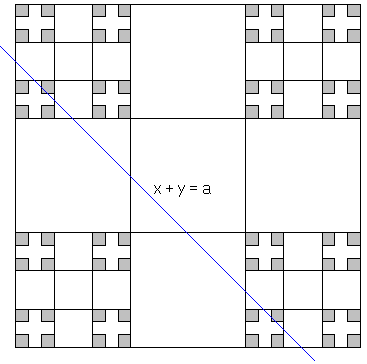C0 + C0 = [0, 2]
Elsewhere I suppplied 3 proofs of the fact that the differences of numbers from 2 triadic Cantor sets C0 fills entirely the closed segment
Here I'll prove the sister question, viz., that the sum of numbers from two Cantor sets fills the interval
For two sets A and B,
A + B = {a + b : a∈A and b∈B}
I wish to prove that
C0 + C0 = [0, 2].
Proof #1
We'll show that every line x + y = a, where a belongs to
The product C0×C0 can be constructed similarly to the Cantor set itself. Draw a 1×1 square, and divide it into 9 squares of side 1/3. Remove 5 "central" squares. Repeat the process in each of the remaining four squares. That is, divide each of them into 9 equal squares of size 1/9 and remove 5 "central" squares. And so on.

It's not hard to convince oneself that the line x + y = a intersects at least one of the 4 "corner" squares with side 1/3. Denote any of these as S1. By the same token, any line with slope 1 that intersects the square S1 intersects at least one of the corner squares of side length 1/9 that are contained in S1. Denote one of them S2. S2⊂S1.
In this manner we obtain a decreasing sequence {Si} of (closed) squares. Since the sequence is decreasing, the intersection of any finite subsequence is not empty. (It's simply the smallest square in the subsequence.) This is another facet of compactness. A sequence of closed sets is said to possess a finite intersection property, if any finite subsequence has a non-empty intersection. A topological space is compact iff the intersection of every sequence of closed sets with the finite intersection property is not empty.
The original unit square being closed and bounded is compact. Therefore, the squares {Si} have a common point. This point belongs to both C0×C0 and the line
Proof #2
Cantor set C0 is symmetric in the midpoint of the inderval
C0 - 1/2 = 1/2 - C0.
We thus can write,
C0 + C0 - 1 =
C0 - 1/2 + C0 - 1/2 =
(C0 - 1/2) + (1/2 - C0) =
C0 - C0.
So that C0 + C0 = C0 - C0 + 1 =
References
- B. R. Gelbaum and J. M. H. Olmsted, Counterexamples in Analysis, Dover, 2003
- I. Stewart, Game, Set and Math, Penguin Books, 1989
Cantor Set
- Cantor set and function
- Cantor Sets
- Difference of two Cantor sets
- Difference of two Cantor sets, II
- Sum of two Cantor sets
- Plane Filling Curves: the Lebesgue Curve
|Contact| |Front page| |Contents| |Did you know?| |Geometry|
Copyright © 1996-2018 Alexander Bogomolny73570693
